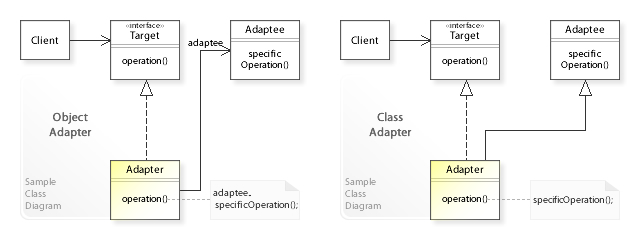"""Adapter pattern example."""fromabcimportABCMeta,abstractmethodfromtypingimportNoReturnRECHARGE:list[str]=["Recharge started.","Recharge finished."]POWER_ADAPTERS:dict[str,str]={"Android":"MicroUSB","iPhone":"Lightning"}CONNECTED_MSG:str="{} connected."CONNECT_FIRST_MSG:str="Connect {} first."classRechargeTemplate(metaclass=ABCMeta):@abstractmethoddefrecharge(self)->NoReturn:raiseNotImplementedError("You should implement this.")classFormatIPhone(RechargeTemplate):@abstractmethoddefuse_lightning(self)->NoReturn:raiseNotImplementedError("You should implement this.")classFormatAndroid(RechargeTemplate):@abstractmethoddefuse_micro_usb(self)->NoReturn:raiseNotImplementedError("You should implement this.")classIPhone(FormatIPhone):__name__:str="iPhone"def__init__(self):self.connector:bool=Falsedefuse_lightning(self)->None:self.connector=Trueprint(CONNECTED_MSG.format(POWER_ADAPTERS[self.__name__]))defrecharge(self)->None:ifself.connector:forstateinRECHARGE:print(state)else:print(CONNECT_FIRST_MSG.format(POWER_ADAPTERS[self.__name__]))classAndroid(FormatAndroid):__name__:str="Android"def__init__(self)->None:self.connector:bool=Falsedefuse_micro_usb(self)->None:self.connector=Trueprint(CONNECTED_MSG.format(POWER_ADAPTERS[self.__name__]))defrecharge(self)->None:ifself.connector:forstateinRECHARGE:print(state)else:print(CONNECT_FIRST_MSG.format(POWER_ADAPTERS[self.__name__]))classIPhoneAdapter(FormatAndroid):def__init__(self,mobile:FormatAndroid)->None:self.mobile:FormatAndroid=mobiledefrecharge(self)->None:self.mobile.recharge()defuse_micro_usb(self)->None:print(CONNECTED_MSG.format(POWER_ADAPTERS["Android"]))self.mobile.use_lightning()classAndroidRecharger:def__init__(self)->None:self.phone:Android=Android()self.phone.use_micro_usb()self.phone.recharge()classIPhoneMicroUSBRecharger:def__init__(self)->None:self.phone:IPhone=IPhone()self.phone_adapter:IPhoneAdapter=IPhoneAdapter(self.phone)self.phone_adapter.use_micro_usb()self.phone_adapter.recharge()classIPhoneRecharger:def__init__(self)->None:self.phone:IPhone=IPhone()self.phone.use_lightning()self.phone.recharge()print("Recharging Android with MicroUSB recharger.")AndroidRecharger()print()print("Recharging iPhone with MicroUSB using adapter pattern.")IPhoneMicroUSBRecharger()print()print("Recharging iPhone with iPhone recharger.")IPhoneRecharger()



